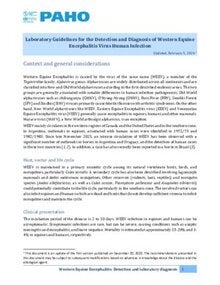Laboratory Guidelines for the Detection and Diagnosis of Western Equine Encephalitis Virus Human Infection

|
Western Equine Encephalitis is caused by the virus of the same name (WEEV), a member of the Togaviridae family, Alphavirus genus. Alphaviruses are widely distributed across all continents and are classified into New and Old World alphaviruses according to the first described endemic areas. The two groups are generally associated with notable differences in human infection pathogenesis. Old World alphaviruses such as chikungunya (CHIKV), O'Nyong-Nyong (ONNV), Ross River (RRV), Semliki Forest (SFV) and Sindbis (SINV) viruses primarily cause febrile illnesses with arthritic syndromes. On the other hand, New World alphaviruses like WEEV, Eastern Equine Encephalitis virus (EEEV) and Venezuelan Equine Encephalitis virus (VEEV) generally cause encephalitis in equines, humans and other mammals. Mayaro virus (MAYV), a New World arthralgic alphavirus, is an exception. WEEV mainly circulates in the western regions of Canada and the United States and in the southern cone. In Argentina, outbreaks in equines, associated with human cases were identified in 1972/73 and 1982/1983. Since late November 2023, an intense circulation of WEEV has been observed with a significant number of outbreaks in horses in Argentina and Uruguay, and the detection of human cases in these two countries (1, 2). In addition, a case has also recently been reported in a horse in Brazil (3). |
